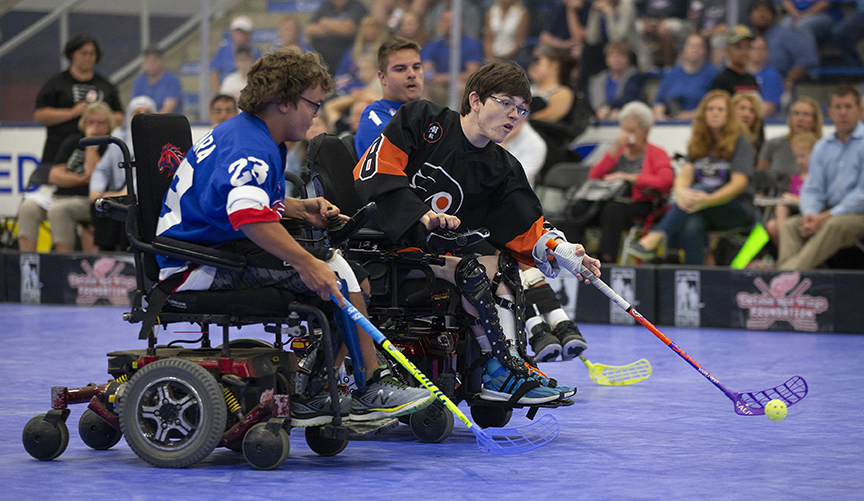Powerhockey is wheelchair floor hockey specifically for persons requiring the use of a power wheelchair in their daily lives. Powerhockey is commonly played on a basketball court with all-plastic hockey sticks and a plastic ball substituted for a puck. The primary source of strength and speed involved in the sport comes from the power wheelchair.
Powerhockey is for both male and female participants 10 years and older of all skill levels. Many participants of Powerhockey have disabilities such as Muscular Dystrophy, Cerebral Palsy, and severe spinal cord injuries. Although these types of disabilities cause severe physical disability, all participants of Powerhockey must have the cognitive ability to follow general rules, strategy, and other aspects of sport.

The most obvious reason is ice and wheelchairs are not totally compatible.
Some not-so-obvious reasons: A high percentage of Powerhockey participants have severe upper-respiratory concerns, meaning long periods of time in cold climates can cause health problems; and excess clothing, to sustain warmth, will impede players ability to play hockey.
The size of a basketball court seems to be the best floor size when considering the speed of wheelchairs and the general flow of Powerhockey. If Powerhockey was played on a larger surface such as an ice or roller rink, the game takes on the look of a much slower paced game. Simply think what would happen, if the NHL would play on a sheet of ice as large as a soccer field. The speed and intensity would not be the same.
As with any sport, uniformity of equipment is important. Because many participants do not have the strength to lift heavy objects (such as wood sticks) the sport is played with all-plastic hockey sticks (both shaft and blade). A plastic ball is substituted for a puck, allowing greater movement during the game. Many players simply use the power of their wheelchair to move and control the ball.
The use of protective equipment, such as pads and eye protection is highly encouraged however at this time it remains optional. Powerhockey is a fairly low contact sport. Most contact during the sport is primarily from wheelchairs bumping each other side to side.
Powerhockey follows many of the same rules found in any ice hockey league, such as the NHL. Of course, rules are adapted to fit the ability of power wheelchair users. For example, Powerhockey goaltenders do not have the ability to reach down and freeze the puck (ball). Thus, the referee blows the whistle when the ball is under the goalie’s wheelchair, prompting a frozen puck (ball). Refer to the official rulebook for more information.

Powerhockey is specifically for persons requiring the use of a power wheelchair in their daily lives. Sports opportunities for power wheelchair users are very limited. In fact, until recently there were no power wheelchair team sports opportunities available. National organizations/events such as Paralympics and Special Olympics (which deals with mental disabilities) have no team sport opportunities for power wheelchair users. Manual wheelchair users have many sports opportunities, such as basketball, hockey, softball, football, racing and rugby to just name a few.
Power wheelchair floor hockey has developed around the world as an incredible sports opportunity for power wheelchair users. Power wheelchair floor hockey is played in many countries around the world. There are teams in Europe, Australia, Canada, and the US. It is thought by many organizers around the world that power wheelchair floor hockey will someday be in the Paralympic Games.
Entirely different disability groups play these two types of hockey. Sled Hockey is a Paralympic sport, played by persons with good to great upper body strength. It would be impossible for most Powerhockey participants to play Sled Hockey.
The above information was provided by powerhockey.com.